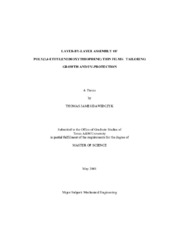| dc.description.abstract | Conductive thin films of poly(3,4-ethylenedioxythiophene)-polystyrenesulfonate (PEDOT-PSS) were created via layer-by-layer assembly. The PEDOT-PSS was used in an aqueous solution as an anionic polyelectrolyte, with both linear and branched polyethylenimine (PEI) and poly(allylamine hydrochloride) (PAH) in the positive aqueous solution. The electrical conductivity was varied by altering pH, concentration, polyelectrolyte, and doping the PEDOT with dimethylsulfoxide (DMSO). The most conductive 12BL samples were doped with 1wt% DMSO and have a sheet resistance of approximately 8kΩ/□. Despite exhibiting good initial conductivity, these PEDOT based thin films degrade under ultraviolet (UV) exposure. UV absorbing nanoparticles were added into the cationic solution in an effort to reduce UV sensitivity. The final bilayers of the films contained either colloidal titanium dioxide (TiO2) or carbon black (CB) and the films were exposed to a 365nm UV-light with an intensity of 2.16mW/cm2 for 9 days. The UV light at this intensity correlates to approximately four years of sunlight. The initial sheet resistances for all samples were similar, but the UV-degradation was reduced by a factor of 5 by utilizing TiO2 and CB in the final bilayers. In addition to being the most conductive after UV exposure, the TiO2 containing film was also 27% more optically transparent than the pure PEDOT films. These additional UV-absorbing nanoparticles extend the operational life of the PEDOT films and, in the case of TiO2, do so without any reduced transparency. | en |


